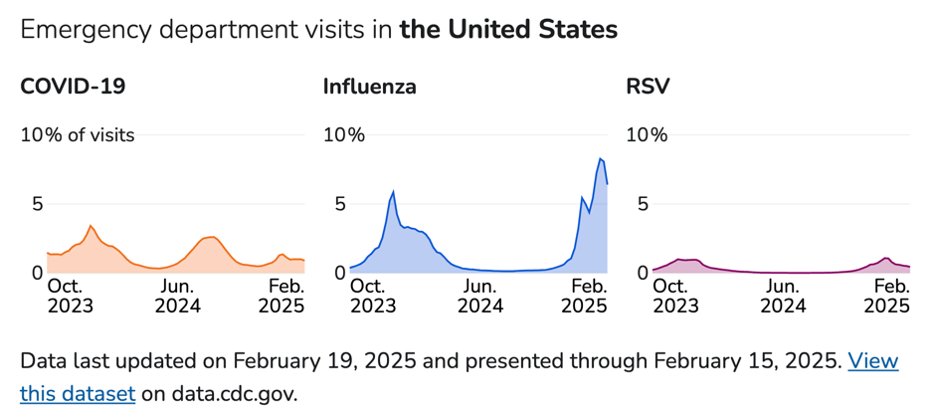8-1/ My COVID update for epidemiological weeks 7-8 of 2025.
The current COVID wave continues to be the mildest in terms of hospitalizations and mortality since the pandemic began. And it doesn't look like LP.8.1 will break out to boost the current XEC wave.
The current COVID wave continues to be the mildest in terms of hospitalizations and mortality since the pandemic began. And it doesn't look like LP.8.1 will break out to boost the current XEC wave.

8-2/ The CDC's wastewater survey shows SARS2 numbers are trending downward in all regions except the Midwest. Note: The CDC normalizes these against the previous year, so they don't give us absolute concentrations. Biobot does, but they haven't published an update in past 2 wks. 

8-3/ While ED visits and deaths due to COVID remain low compared to previous waves, influenza is the respiratory virus causing the most ED visits — although we're probably past the peak for flu cases now. 





8-4/ And LP.8.1's growth rate is slowing. So, while it may have caused a secondary blip on the current wave, it's not going to create a larger wave than we've just experienced. 



8-5/ In other pathogen news, we've got a measles outbreak in TX and NM with over 100 people infected. I'll remind folks that the mortality rate for measles is 0.1-0.3 percent. Young children are especially susceptible.
bbc.com/news/articles/…
bbc.com/news/articles/…
8-6/ Measles is a particularly nasty pathogen because, unlike COVID-19, measles infection can cause "immune amnesia," severely depleting immune memory cells, leaving children more vulnerable to other diseases that may impact brain health.
hms.harvard.edu/news/inside-im…
hms.harvard.edu/news/inside-im…
8-7/ Research has shown that children who survive severe measles infections have long-term cognitive deficits, including lower IQ scores and impaired executive function. And longitudinal studies have shown vaccinated kids have better educational outcomes.
pmc.ncbi.nlm.nih.gov/articles/PMC66…
pmc.ncbi.nlm.nih.gov/articles/PMC66…
8-8/ If RFK has his way, we're going to see bigger outbreaks of measles and other infectious diseases in the coming years.
medpagetoday.com/infectiousdise…
medpagetoday.com/infectiousdise…
8-9/ Adam Kucharski posted an interesting article on COVID reinfections. He calls the claim that immunity to SARS2 wanes rapidly a "zombie statistic."
kucharski.substack.com/p/a-zombie-sta…
kucharski.substack.com/p/a-zombie-sta…
8-10/ Yes, NAb titers drop after infection or vaccination, but they level off, and they remain high enough for the long term to prevent reinfection from the *same* variant. Kucharski argues convincingly that it is novel variants that are getting past our immunity. 

8-11/ And finally, here's a neat chart by Biotecnika that maps out the components of our immune system — h/t to @OGdukeneurosurg for posting it! 

8-12/ That's it for this update. See you in two epi weeks.
@threadreaderapp unroll
• • •
Missing some Tweet in this thread? You can try to
force a refresh



























